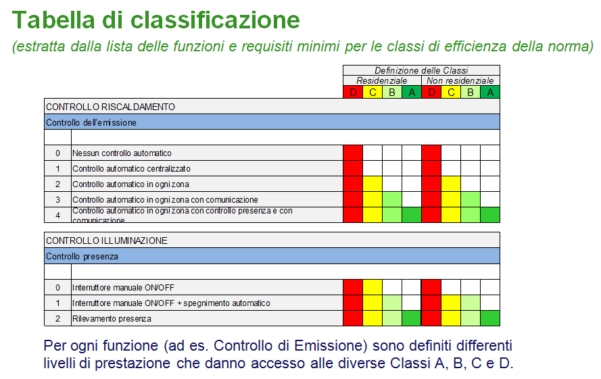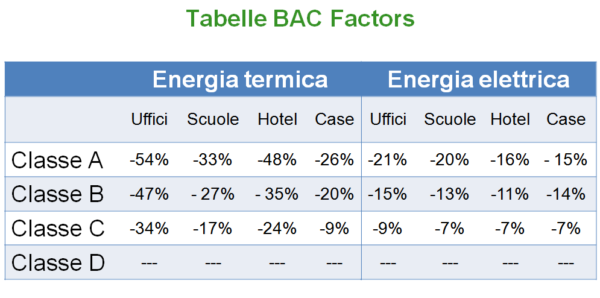
European EN15232 standard
“Energy performance of buildings – automation, control and building management influence”
The EN15232 is born in order to establish the impact of building automation on the energy performance of buildings.
The standard defines:
- a structured list of control, functions of building automation and technical building management with an impact on energy efficiency;
- a method for the definition of minimum requirements to be implemented in buildings of different complexity;
- methods for defining the impact of the automation functions on a given building, allowing to assess the impact through ratings and indicators calculation according to prEN-15203 and prEN-15217;
- simplified method to give a first estimate of the impact of automation on a given type of building.
In detail four energy efficiency classes are defined for the evaluation of automation services that are not to be confused with the energy class of buildings:
- D Class “Non energy efficient”: Works without automation, energy-inefficient
- C Class “Standard”: Works with automation achieved with traditional or bus systems with basic functions
- B Class “Advanced”: Works with automation built with bus systems and centralized coordination functions
- A Class “High Energy Performance” : As a class B, but with levels of accuracy and completeness of the automatic control such as to ensure high energy performance to the system.
And the control system functions and the minimum requirements for the Energy Efficiency classes:
- Automation functions
- heating, cooling control
- ventilation and air conditioning control
- lighting control
- solar shading control

For each function are defined different levels of complexity depending on the energy efficiency class.
An automation system is of a particular Energy class if all the functions that implements belonging to that class.
How to calculate the energy savings?
DIRECT method
Analytical calculation procedure used only when the system is fully known: building housing, control / command / automation management functions, etc.
Method of “BAC Factors”
Procedure of calculation on a statistical basis, allows to estimate with a good approximation. Useful both in the initial design phase and in the verification phase.
- It allows us to estimate the impact of building automation for achievable energy efficiency
- It was developed through simulations on a local reference standards considering the occupation times, user profile, weather, sun exposure, etc.
- It uses through tables with efficiency factors (BAC Factors) that, depending on the type of building and the use of automation Efficiency Class provide the attainable energy saving.
